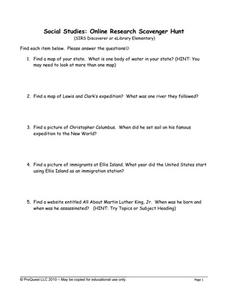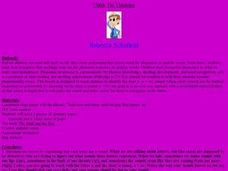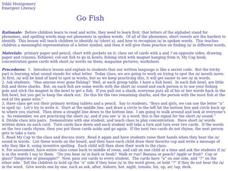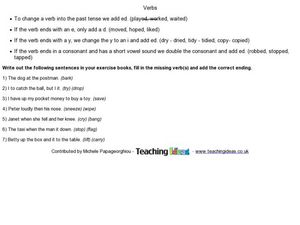Curated OER
Short 'e'
First graders recognize the short vowel e in written and spoken language. Through matching activities, they discriminate the short vowel /e/ from other phonemes. Students associate the phoneme with its letter representation and identify...
Curated OER
Short Vowel U: Circle and Print #2
In this short vowel u worksheet, students circle the word in a pair that has the short u sound, then practice printing the word on a line beneath. A reference web site is given for additional activities.
Curated OER
Mr. Cloak Loads his Boat with Oats
First graders distinguish between the sounds for short vowel o and long vowel o. They are introduced to the vowel patterns that comprise long vowel sounds, with a particular emphasis on /oa/. They practice reading and identifying a...
Curated OER
Bee a Good Reader
Being able to distinguish between the sounds for short vowel e and long vowel e is an important skill. Young readers are introduced to the /ee/ vowel pattern that makes the long vowel sound. They practice reading and identifying a...
Curated OER
Sound the Foghorn
Learners complete a variety of activities related to the long /u/ sound. As a class they recite a tongue twister, then trace and write the letter U. Students then listen to pairs of words and identify which word contains the long /u/...
Curated OER
Lick Your Icky Sticky Fingers
Students complete a variety of activities related to the short /i/ sound. As a class they recite a tongue twister, then spell different words containing the short /i/ sound using letter manipulatives. Students listen to the book "Liz...
Curated OER
Ouch! I have a booboo
First graders recognize the short vowel o in written and spoken language. Through matching activities, they discriminate the short vowel /u/ spelled ou from the short vowel /u/ spelled u. Students associate the phoneme with its letter...
Curated OER
Icky Sticky Tin Man
Students recognize the short vowel i in written and spoken language. Through listening and matching activities, they discriminate the vowel sound /i/ from other phonemes. Students associate the phoneme with its letter representation and...
Curated OER
I'm Thinking
Students recognize the short vowel u in written and spoken language. Through matching and listening activities, they discriminate the vowel sound /u/ from other phonemes. Students associate the phoneme with its letter representation in...
Curated OER
Go Fish
Students recognize the short vowel a in written and spoken language. Through matching activities, they discriminate the short vowel /a/ from other vowel phonemes. Students associate the phoneme with its letter representation in a story...
Curated OER
Batter's Up
Pupils recognize the short vowel a in written and spoken language. Through matching activities, they discriminate the short vowel /a/ from other vowel phonemes. Students associate the phoneme with its letter representation and identify...
Curated OER
Nick's Sticky, Icky Fingers
Students examine the letter 'i'. Through instruction and modeling they explore the sound the letter makes, how the letter is written, words that contain the letter, etc. They use letterboxes to write 'i' words and read stories containing...
Curated OER
High Frequency Words: lesson 27
In this high frequency words worksheet, students complete high frequency word activities by writing ou sound words, fill in the blanks to sentences, and answering short answer questions about stories. Students complete 4 activities total.
Curated OER
Ah Ah Ah! Don't Do That!
Students become familiar with the alphabetic principle that letters stand for phonemes and spellings map out the phonemes in spoken words. They focus on identifying the short /o/ sound in spoken words and the tongue twister "Oscar Otter...
Curated OER
Fluency is Freedom!
Students read orally in groups of two to increase reading speed and fluency in this instructional activity. They read provided books which emphasize the short vowel sounds. The pairs time each others reading and offer encouragement and...
Curated OER
Test Your Speaking and Listening Skills IPA Test 2
In this recognizing pronunciation worksheet, students use the IPA to write English words with given vowel and consonant sounds, diphthongs, and stress marks. Students write 17 answers.
Curated OER
Adam's Apples
Students examine the /a/ phoneme in both written and spoken words. They practice finding the /a/ in words, watch how their mouths move when making the sound, and write the letter. Next, they differentiate the sound in words, listen to a...
Curated OER
Doctor Check-Up
Students recognize the short vowel o in written and spoken language. Through matching activities, students discriminate the short vowel o from the long vowel o. They associate the phoneme with its letter representation and identify the...
Curated OER
Open Wide
Students recognize the short vowel o in written and spoken language. Through matching activities, students discriminate the short vowel o from the long vowel o. They associate the phoneme with its letter representation and identify the...
Curated OER
"Ehhh" I can't hear you!
Students practice writing, sounding out, and identifying words using the short "e" sound. They listen as the teacher reads a tongue twister emphasizing short "e" beginning sounds. The stuents then participate in an activity in which...
Curated OER
Verbs - Adding -ed Endings
For this grammar and spelling worksheet, students read the proper ways to add -ed endings to verbs. They write out 7 sentences filling in the missing verb and adding the correct ending.
Starfall
Ii is for Igloo
For this printing worksheet, students form the upper and lowercase letter Ii. Students also color in pictures that begin with the letter Ii.
Starfall
Ii is for Igloo
In this literacy instructional activity, learners look at the formation of the letter I and practice creating it. Then they use the pictures to make cognitive connections to help with spelling.
























